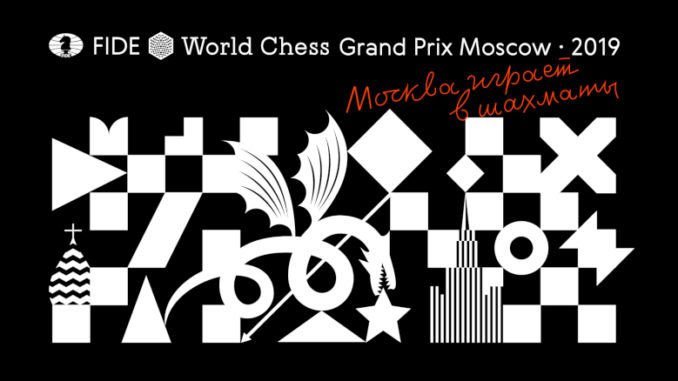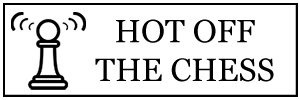
The final of the FIDE Moscow Grand Prix 2019, will be an all-Russian affair, between Ian Nepomniachtchi and Alexander Grischuk. The two emerged the victors in their semi-finals, against Radoslaw Wojtaszek and Hikaru Nakamura respectively.
Grischuk made rather light work of things in his match against Nakamura. He wrapped things up in the classical section, 1.5-0.5. Their first game was a rather uneventful draw in 35-moves, but the second turned into quite a kicking for the American.
It was an Open Catalan, with Grischuk White. Both players opened the game well and showed good preparation. They will both have been rather satisfied, I would think. The diagram, below, shows the situation after Black’s 22…Ra7.
The position is about equal, here, but White’s is perhaps the more comfortable. The reason I say that, is because I really don’t like the Black c-pawn. I know that may seem a rather silly thing to say, but it seems rather fixed and backward, don’t you think?
Let’s say, that after White’s next, which was 23.h4, Black would want to play the text book answer of 23…c5. White then plops the d4-knight into b5, which is rather nice. Nicer still is that the c4-square is ready for the other knight.
This said, c6-c5 seems out, then, but that begs the question as to what Black’s Queenside is up to. If it stays on c6, White will sooner or later occupy the c5-square. This may seem a small thing and it probably is, but chess often boils down to small things. It is just how I see it, but due to White having no obvious weaknesses, it suggested to me that he was better and Black was defending.
And it was indeed the Black Queenside, that allowed White to get a grip on the game. It wasn’t quite how I imagined it, Grischuk set his knights on c4 and b3 and ended up netting the a5-pawn. With his h-pawn sneaking up the board to h6, Nakamura will have been concerned about both sides of the board. And it proved too much to answer, Grischuk’s advantage steadily improved and Nakamura’s Queenside was ultimately obliterated. After 54-moves, Alexander Grischuk became the first finalist.
When it came to the other semi-final, it was a different matter. Ian Nepomniachtchi and Radoslaw Wojtaszek drew their classical games without too much effort and then had to play four tie-break games to decide things. This proved a cruel affair for the Polish Grandmaster.
Radoslaw had the best of things in the first rapid game, but not enough to do anything, and in the second, he was handed good chances by Ian, who went for an extremely questionable exchange sacrifice.
In the position shown above, the Russian went for 26.Bxh6(!?) which is a very dubious decision to say the least. It is not like White was struggling for other good moves, here either. As it was, from a position of relative equality, after 26…gxh6 27.Qg4+ Kf8, White appeared to have fallen on his own sword.
However, then came 28.Qh4 f6, which allowed White to escape with repetition. Had Black played 28…Qd8, he may have had one foot in the final. It is true to say that he may also have lost, but after 29.Qxh6+ Kg8, it does not seem like White has enough, if anything, to kill his opponent off.
Into the ten-minute games, then, and Wojtaszek took White in game one. He did well against Nepomniachtchi’s Grunfeld Defence and perhaps could have gone for more than the half point that he ended up with. As it was, the players switched colours and prepared for a fourth tie-break game.
And here is where the wheels fell off of Radoslaw’s bus. Playing Black in a Sicilian Defence, he was doing alright, until his clanger of clangers, 18…Bc5(?? 18…f5 was about equal). This is shown in the diagram, below.
Wojtaszek had likely been rather concerned about Nepomniachtchi’s battery of Queen and rook along the d-file. He doesn’t want to leave his knight on e8 forever, for example, but should he move it, his opponent could get up to mischief by means of discoveries with the Nd5. The other factor is space, Black would be rather happy if he could free his position a bit and maybe exchange a piece or two.
Accordingly, 18…Bc5 looks useful — until one takes into consideration, the fact that the piece can not desert the e7-square, (due to Ne7+, forking King and Queen). However, these are the kinds of things that are easy to overlook or take one’s eye off of when time is short and that seems to have been what happened here.
As a consequence, after Nepomniachtchi’s 19.b4(!) Black is already in huge trouble. The bishop is forced to return from where it came, which is embarrassing enough. However, then comes 20.c4(!) as shown in the diagram, below.
The threat, here, is simply c5, but there is also the added issue of the Queen and rook battery along the d-file as the Bd7 is also not looking too secure. There were just too many problems for Wojtaszek and he was resigning not too long after. A disappointing way to end what had been a very good tournament for him up to that point.
And so, sixteen players had become two, Ian Nepomniachtchi and Alexander Grischuk. I mean no disrespect to either when I say that perhaps this may come as a surprise to some, but it is down to them to contest the final. First, however, the two countrymen would get a rest day, before commencing battle.

